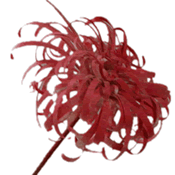
Today’s flower arrangers are spoilt for choice. Wonderful natural material is available from around the globe, all the year round. Fifty years ago one had to rely on what was grown in season in one’s own garden or the limited range stocked by the local florist whose main business was supplying weddings and funerals.
It’s the same with artificial flowers. Remember those awful plastic examples from Hong Kong, heavily molded lurid reds and greens that fooled no one? Today, artificial flowers and foliage can be unbelievably life like, but until very recent times there was only another source of artificial flowers for the ordinary home: from the Romanies or Gypsies. These itinerant folk have been wandering the English lanes for the last five hundred years. They originated in northern India from where they started their migration west over a thousand years ago. Why they suddenly left their native land is still an unsolved mystery to scholars.
Romanies have always lived just outside ‘normal’ society and learned to live with and from nature.
We have all heard of their exploits regarding poaching, taking just what they needed from the wild to survive, but no more. This ethos ran through nearly all that they did. It was the same with their traditional crafts whether peg making or weaving baskets, they took from the hedgerows the Hazel and Willow freely provided. This was working with nature, and the more that Hazel and Willow are cut the more it will grow, it was using a renewable resource.
Another of the Romany crafts was making artificial flowers. Various materials were used, pink and red roses were expertly moulded by hand from candle wax and fixed to twigs. Coloured crepe paper was cut with scissors, deftly folded, tweaked and wired onto a single twig stem.

The most impressive blooms however were created from wood, Elder being the Romanies’ preferred material.
Elder produces extremely fine ‘petals’, flower heads in excess of six inches were common and resembled large Chrysanthemums. I have seen similar flowers made by gypsies in Eastern and central Europe, it seems to be a deep-seated tradition.
A short peg knife is the only tool required. The Elder should ideally be from two /three-year-old shoots cut into manageable lengths of about eighteen inches long. The knife is used to remove the bark, then with the back of the knife held firm against the knee the stem is pulled against the knife blade to produce a long curly shaving. This is the first of many petals that are subsequently created in turn; one next to the other as the wooden stem is slowly rotated and pulled against the blade. This continues until the flower head is released from the Elder stem. The next step is to mount the flower head on to a suitable looking stem. There was no need to drill a hole in the base of the flower, as the central pith of the Elder was soft enough to allow the proposed stalk to be pushed in. Privet was the favorite choice with its straight growth and shiny dark green leaves.
The Privet was usually ‘harvested’ after dark from the hedges of cottager’s who would often unwittingly buy back their own Privet, complete with flower heads the following day as the Romany women went selling door to door. Some flowers were sold natural, other were softly coloured, either by using natural vegetable or fruit stains or the leached-out dyes from crepe paper put into a bucket of water.
I learnt the craft from an old Romany called ‘Gypsy John’ whose proud boast was that he was born in a traditional Gypsy wagon at Stow in the wold’s annual Horse fair. I have demonstrated making Gypsy flowers at country and craft events for over twenty-five years now. Rather than using the peg knife method I use my homemade ‘Flower Horse’, a simple three legged stool contraption that contains a horizontal knife blade. I find the public never cease to be enthralled when they witness a flower made from wood evolve in front of them in just ninety seconds. Rather than use Elder I have come to prefer Hazel wood as it is very predicable and grows in abundance in my native Chiltern Hills.
